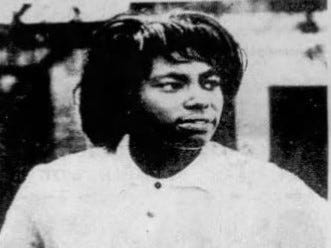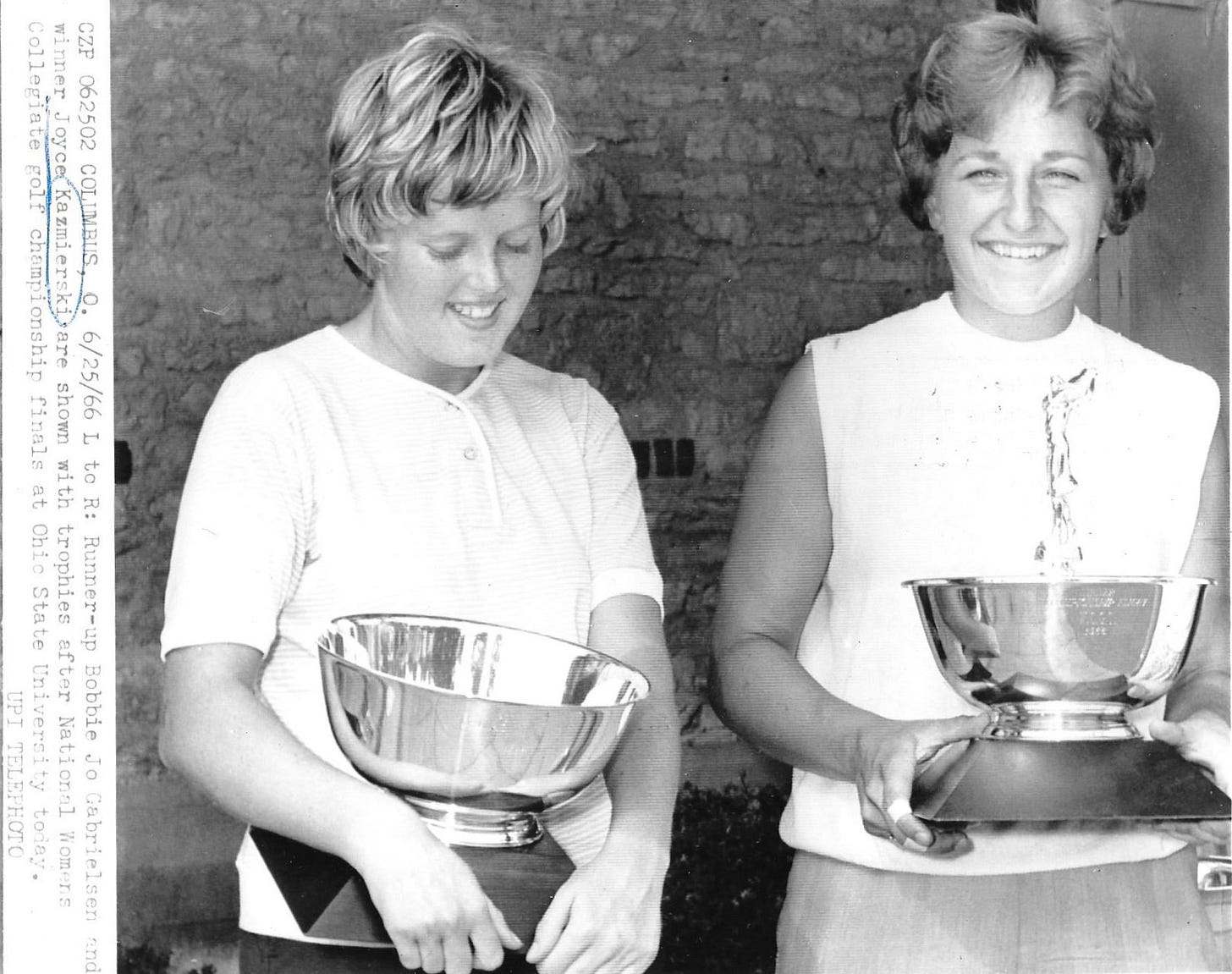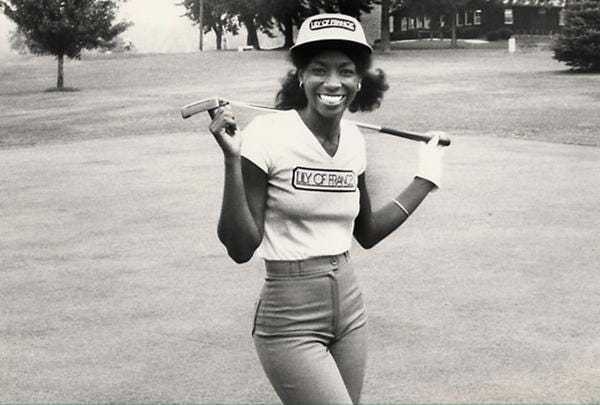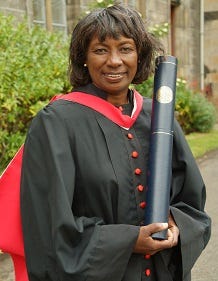This is part of a series on the Women’s Collegiate Championships
The 1960s were a time of significant change for the Women's Collegiate Golf Championship, in some ways mirroring that of the nation at large. One of the best collegiate players in the state of Ohio also happened to not resemble many of her peers on the course, a fact ignored by some news outlets and bolstered by others. Representing the University of Ohio, Renee Powell broke the color barrier at the 1966 women's championship, hosted once again by Ohio State for the first time since the early 1950s. She returned to the championship the next year as a member (and captain) of the Buckeye team, making even more history. Change was also happening once again at the leadership level as the Tripartite was dissolved and replaced by a national organization with it's focus set on embracing and expanding women's collegiate sports. The times they were a-changin’.
*NOTE 1: underlined text provides a link to references or sites with more information
*NOTE 2: we have done our best to cull out sources that contain problematic language or sentiments, but sometimes those things cannot be helped or are otherwise included to illustrate a point; we hope you understand this usage and recognize its educational purpose is not an endorsement
DEATH OF GLADYS PALMER
The great Gladys Palmer died in early 1962 after several months of illness. Even after The Ohio State physical education department stopped being the primary host for the tournament, she was still an integral part of the Women’s Golf Championship and lived long enough to see her efforts recognized in the form of a trophy bearing her name. Over six decades later, her legacy is still strongly felt every year the women tee it up and is embodied annually with the Women’s Golf Coaches Association (WGCA) presentation of the Gladys Palmer Meritorious Service Award.
THE TOURNAMENT [June 20-25, 1966]
For the last decade - practically since the university had stopped exclusively hosting the event - the plan had been for the Women’s Collegiate Golf Tournament to return to Ohio State’s famed Scarlet Course for the Silver Anniversary. The celebration of 25 years (but not 25 playings due to WWII) of the tournament was a big deal that brought in a record number of competitors.
An interesting problem arose with a Canadian team entry from the University of British Columbia. Although they were allowed to compete, the Committee was forced to finally decide if this was a national or international event. After the tournament they chose to amend the language on the entry process, allowing only qualified players from colleges and universities inside the United States. Thus, 1966 is the answer to a trivia question that nobody has ever asked: When was the last time that an international team competed for the US Women’s Collegiate Golf Championship?
STROKE PLAY
INDIVIDUAL RESULTS
The course was crowded the Monday to start the tournament with the most entrants (105) in history, over three times as many as had played in that first event 25 year prior. It was a great day for golf, which the scores reflected as a majority of the expected strong competitors bunch up between the mid-70s and 80s.
There were four co-medalists finishing at 75 (+1) including Bobbie Jo Gabrielsen [Georgia], Jeannie Butler [Odessa], Peggy Conley [Washington], and Dorothy “Dot” Germain [Monticello College]. It seems that due to the large number of competitors on the course and lack of time, there was no tie-breaker for medalist honors. Renee Powell [Ohio University], reported to be the first African-American woman to compete in the tournament, shot a 77 to finish close behind the leaders. Defending champ Roberta Albers [Miami (FL)] was misreported in some newspapers (such as the one below) as having been one of the medalists, but actually fired a (still respectable) 78/+4.
TEAM RESULTS
Odessa College made history as the first junior college to take the women’s golf team title. They were led by Jeanie Butler (75) and Jan Ferraris (77) - 1963 US Girls Junior Am and Women’s Western Junior Am champ - who combined for a 152, four strokes better than the Washington University duo. The team results were as follows:
152 - Odessa College
156 - Washington
160 - Illinois State, Michigan State, Cal State LA
161 - Ohio State
162 - Arizona State, British Columbia
166 - Missouri
167 - New York State, Ohio University
169 - Penn State
170 - Kent State, Southern Illinois
172 - Georgia
183 - Northern Illinois
192 - Michigan
195 - UNC
211 - Central Connecticut State
MATCH PLAY
Due to the large number of competitors, the qualifiers for match play was expended to 32 players for the first time. Even still, it took a score of 82 or better to qualify, meaning only 7 strokes separated the medalists and the final entrants; the field was jampacked with a number of players who could make a run.
One of those hopefuls was Renee Powell [Ohio], who just never got her game going that Tuesday morning, losing in the first round to Alabama College’s Joyce Ann Jackson (1967 Alabama State champion). Another surprise first-round exit was co-medalist Dot Germain [Monticello].
The first truly big matchup of the tournament came with the second round meeting of defending champ Roberta Albers and Tennessee’s Ann Baker. The former continued her quest for a repeat with a 3&1 victory. Albers’s progress was halted in the Elite 8 by co-medalist Bobbie Jo Gabrielsen [Georgia] who finally took the match after 20 grueling holes. Surprisingly, it was the second match in a row that Gabrielsen won on the second playoff hole.
The semifinals featured a thrilling matchup between Jan Ferraris [Odessa] and Gabrielsen who curled in a 20-footer on 16 that hung on the lip of the hole for several seconds before dropping to give her the lead and eventual win. After the match, Ferraris announced she was turning pro and despite joining the LPGA mid-season, still went on to be named the Rookie of the Year. In the other match, another tournament favorite (behind the defending champ Albers) Joyce Kazmierski [Michigan State] defeated Nicki Nordstrom [Arizona State] 4&3.
The Finals match this year was extended to 36 holes which all but guaranteed a fun final day, and spectators were treated to an interesting mix in match play philosophies. In this Sports Illustrated article on the tournament, Bobbi Jo described her approach as being the “play-your-opponent theory” where it didn’t matter what the final score was so long as you won more holes. Kazmierski on the other hand stated she felt that only worked in the final 9 holes while the first 27 should be spent competing against par rather than your opponent. Both players had used their respective approaches to great success, but in this matchup it was Joyce who came out on top, winning 2&1. That same Sports Illustrated article has a great recap of the Finals match and is well worth the read.
Along with being enshrined in the Michigan State sports Hall of Fame, Kazmierski would later join Eleanor Dudley (Copping) [Alabama], Joanne Gunderson (Carner) [Arizona State], and five other players as charter members of the Women’s Golf Coaches Association (WGCA) players Hall of Fame in 1986.
RENEE POWELL
BEFORE COLLEGE
Renee Powell seemed destined to be a golf star from an early age. She grew up learning the intricacies of the game in Canton, Ohio on the Clearview Golf Club course that her father, William “Bill” Powell, built. She was a highly successful junior player who won many regional tournaments, but it was more of a struggle to get onto the course than it was to get the ball in the hole. Before the start of her junior year in high school, she made it into the field for the US Girl’s Junior Amateur, becoming the first African-American girl to play in that event.
“It was my first big tournament,” she said. “I was 16. Back then, when you read the write-ups, I was referred to as ‘Renee Powell, a Negro from Ohio.’” (via this CantonRep article)
OHIO UNIVERSITY
As the Canton Repository article on her prolific career recounts, Renee was used to the phrase “…first African American to…” starting off news stories. At Ohio University, she continued generating news articles beginning with that sentence for things like: shoot a sub-par round, competing in the Midwest Intercollegiate tournament, earning golf team captain, and even being in contention for a spot on the Curtis Cup.
She was originally registered to play in the 1965 women’s collegiate championship tournament held at Florida. According to correspondence between UF’s Betty Graham (tournament chairman) and Phyllis Bailey (Ohio State), arrangements had been made for Renee to room with one of the Ohio State girls who:
“…were very pleased Renee was going to be there and said any of them would be happy to room with her…they expressed an immediate concern for her and wanted her to feel comfortable, so felt it might be important to pair her up with our gals.”
Unfortunately, Powell withdrew from the tournament for unspecified reasons in late May. At the same time the collegiate tournament was being played, she spent her time winning the Conneaut Lake Club (PA) Women’s Invitational - with a three under-par 69 - and practicing for the upcoming (July 1, 1965) US Women’s Open.
THE OHIO STATE UNIVERSITY
Following her sophomore year at Ohio, Renee transferred to the Ohio State University. According to her Ohio Golf Association Hall of Fame profile, the reason for the transfer had to do with her displeasure with the golf coach at Ohio choosing not to have her compete at a tournament in Florida “due to the potential for racial tension.” That wasn’t her only tie to the university which had gone to bat for her on multiple occasions, such as in the 1965 collegiate golf tournament and even getting into the Ohio Golf Association state tournament. She fit right in at Ohio State and was eventually named the team captain a second time; an honor that very few, if any, other women of any race could claim.
Renee returned for the 1967 Women’s Collegiate Championship where she won the consolation bracket after losing to defending champ Joyce Kazmierski in the first round. Earlier that season she won the fourth annual Wooster Collegiate Invitational tournament, which probably generated the expected headline somewhere.
AFTER COLLEGE
Two days after the 1967 championship and only a few days before the US Women’s Open (where she finished T35), Renee Powell officially turned pro, becoming the second African-American woman on the LPGA Tour following Althea Gibson who beat her by three years. That was the beginning of a 13 year career on tour that had many ups and downs.
"The problems came from outsiders," Powell said. "The '60s were a turbulent time. We played in places in the deep South where there were many challenges, but it wasn't only in the South. There were plenty of places elsewhere in the country where I wasn't welcome as a Black woman in golf. There were always people who welcomed me with open arms, too." (via this CantonRep article)
Towards the end of her playing career, Powell moved to England and became the first woman to be the head professional of a private club in the UK. Eventually she moved back to Canton, OH to take up the role of Head Pro back where it all started, Clearview Golf Course.
In 2017 she joined her father (2012) in the PGA of America Hall of Fame, becoming the first father/daughter combo to accomplish that feat. In 2019 she was awarded the Golf Course Superintendents Association of America’s Old Tom Morris Award. That same year, The Clearview Golf Course was awarded an Ohio Historical Marker, indicating its significance as a historical landmark. Among her countless other awards and honors are a series of special ones that tie her to the Home of Golf at St. Andrews, Scotland:
In 2008, Renee became the third American, and the only woman golfer, to ever receive an honorary doctorate from The University of St. Andrews. In 2015, she became one of two American women initially given honorary membership into the Royal and Ancient Golf Club of St. Andrews. And in 2018, the 600-plus year old University of St. Andrews made Renee the first American to have a campus building dedicated in her name.
-via the Clearview Golf Club website

NEW LEADERSHIP: CIAW (DGWS)

TRIPARTITE DISSOLVED
The February, 1965 conference proposed by the American Alliance for Health, Physical Education, and Recreation (AAHPER) to study the “competition for girls and women” resulted one of the most positive moves in women’s extramural athletics. The conference was attended by twenty participants - eight of which were men - across multiple organizations and concluded with the Division for Girls’ and Women’s Sports (DGWS, division of the AAHPER specifically for the sports aspect) telling the nation that it was ready to fully embrace high school and college athletics for girls/women.
One of the primary goals of the Tripartite Committee, which had overseen the golf tournament since 1956, had been to leverage the combined efforts of three large organizations related to women’s athletics to develop a standard for running championships which could broadly apply to multiple sports. The DGWS’s decision to utilize this standard set by the Golf Committee as the basis for other championships meant that the Tripartite Committee (and its larger/clunkier parent group called NJCESCW) had effectively realized its goal, and thus was no longer necessary. Although the group was dissolved and essentially folded into the DGWS, there was still a need for the same structure to continue running the golf tournament. The group directly responsible for the year-to-year running of the tournament was dubbed the Collegiate Golf Committee starting in 1966.
CIAW CREATED
In order to handle the national organization of extramural athletic competitions for women’s collegiate teams, the DGWS created the Commission on Intercollegiate Athletics for Women (CIAW). This group, which had vast responsibilities of which golf was only a (foundational) part, was formed prior to the 1966 golf championship, but a number of practical organizational aspects weren’t fully ironed out until 1968, which made for an awkward few years for the Collegiate Golf Committee.
The first move for the CIAW was creating a booklet called Procedures for Women’s Intercollegiate Athletic Events. The biggest move was to effectively start the process of creating actual membership - similar in function to the NCAA - rather than being strictly a national body that generated guidelines and recommendations to those colleges seeking organization. This was an intermediary step towards what would become the AIAW (covered in the next post), which was essentially a realization of the “Women’s NCAA” that Ohio State had proposed and tried to start way back in 1940.

EMPHASIS ON GROWING WOMEN’S COLLEGIATE GOLF
As mentioned in the 1966 Collegiate Golf Committee report, with the CIAW came a new emphasis on the establishment of state and regional collegiate golf events. A few years earlier, the annual Midwest Women’s Collegiate Golf Tournament was instituted and hosted by many of the schools in the Midwest region, especially by those who participated in the Big 10 conference for men’s athletics. By the end of the decade, other regional and even national women’s tournaments were created to supplement the growing number of dual matches commonly played in the Spring. A new era of women’s collegiate golf was dawning.
Thanks for reading!
Up Next:
In the next post for this series, we will cover the beginning of the AIAW (Association for Intercollegiate Athletics for Women) and a format change over to stroke play only starting in the early 1970s.














